July 1, 2008 Canada: A Good Neighbor
Today is Canada's Independence Day celebrated with much of the same fanfare that will take place in the southern neighborhood only three days from now. We North Americans share the longest unguarded border, and we join in true fellowship in times of need. We have worked together for over a century and a half, even though our past history took divergent paths. The United States was unsuccessful in getting Canada to forsake the British Empire, and cultural and historical differences will most likely continue to divide us for some time. Even though we see differently about constitutional issues, we can remain good friends and respect each other's independence. However, with NAFTA and the mixed fruits of interconnectedness, we wonder about what the future economic benefits and stumbling blocks will be. But we must work together.
In truth, Canadian winters would be hard on many of us senior citizens, and from the string of Canadian vehicles heading down I-75 to Florida each autumn we can surmise Canadians think the same way. I don't blame people who look for southern vacations or residences in our southland; but in spring time when their caravans return north I envy their Canadian summer weather.
All things said, Canada is vast; it is blessed with grandeur; it is scenic; it is open country; and it has friendly and hospitable people who assist when neighbors are in trouble, which we learned at 9-11. These are characteristics that assist us who also share the breadbasket in the world: the Great Plains and Midwest.
With this impending world food crisis that is bound to get worse we North Americans must work together in making use of our vast resources. Our crop selections must not involve taking valuable land and energy resources to produce wasteful biofuels to run inefficient vehicles while Africa and other places suffer under inflated food prices. Our joint efforts must be given to sharing surpluses with others who are in need and to using our land gifts properly, for they are all part of the global commons.
As this harvest season comes to an end, many Canadians and some of the geese will go south. Maybe there is a wisdom to it for they have avoided the air conditioning needed in Florida during the summer and the extra heating costs of the Canadian winters. We work together because for better or worse we are together. In this sense of cooperative endeavor we need to forge a joint policy of becoming the furnishers of extra grain, soybeans, edible oils and other produce for a hungry world. Our crusade should not be focused on our two nations; by working together we should soon extend our joint efforts to include other food exporting nations throughout the
world.
Prayer: Lord, help us to be good neighbors, to be frank in expressing our disagreements and to be quick to cooperate on matters that affect the lives of less fortunate people, both those within our boundaries and those in other lands with hungry people to feed.

Shoreline at Manistique, MI
(*photo credit)
July 2, 2008 Examining Our Response to the Food Crisis
The first half of 2008 experienced a new problem when global food surpluses ceased and shortages appeared. The crisis has multiple causes: enhanced demand for food by China, India and emerging middle class countries; higher fuel and fertilizer costs discouraging farmers from food production; conversion of grain-growing cropland to parking lots, roads, businesses and recreational areas; conversion of corn and sugar to biofuels; and reluctance of grain exporting lands to allow sales abroad. What can we do? Our soggy bowl of breakfast cereal cannot be shipped to another land or hardly next door. But can we take some constructive steps to alleviate the food shortages?
Home-grown and local:
Do I grow some of what I eat -- even a small amount if garden space is scarce?
Do I seek to meet my food needs from outlets closer to home, or do I purchase foods originating in distant places? Do I patronize local small-time farmers?
Do I share food surpluses with those in need in the local or broader community?
Nutritious foods:
Do I eat excessive amounts of non-nutritious (often labeled "junk") food that has excessive (animal) fats, empty refined sugar and food additives?
Are soft drinks too readily available? Do I challenge the non-nutritious food habits of others within reasonable limits? Do I continue to read and reflect on the need for more wholesome diets? Do I practice proper cooking and baking habits in my own life?
Low-priced basic foods:
Do I find that I can be satisfied with lower priced foods such as beans, split peas, cornmeal and rice -- items that can be prepared in a nutritious and satisfying manner? Am I willing to reduce meat consumption, to forgo prepared and overly packaged foods and to do more cooking on my own? Do I encourage others to do the same through sharing of information and educational programs?
Have I cut down on and encouraged others to use foods that take far fewer resources to develop and prepare than do basic grains and home-grown
produce?
Food wastes: Do I waste food in any way, taking more than I (or those under my charge) can possibly eat? Am I willing to promote food-saving techniques in the institutions with which I am associated?
Food supplies: Am I willing to promote the availability of good food for those who find inflated food (and fuel) prices cutting deeply into their budgets? Do I assist others to obtain food stamps or WIC supplies when they deserve to have them, and do I help them make correct selections when choosing their food?
Prayer:
Lord, thank you for the gift of our daily bread. Help us to become mindful of our fellow human beings and their needs by gradually reducing our dependence on resource-intensive foods such as animal products and overly-packaged foods.

Robinia hispida, rose acacia
(*photo credit)
July 3, 2008 Confrontation: Good or Bad?
Recently someone in a rather heated manner charged me with being "confrontational." His negative sounding remark left me confused because I regard this quality to be a positive blessing (for which I pray), not something negative. In an age that does not take global warming seriously, nor sees anything wrong with making biofuels from our limited food and feed supply, and has witnessed an economic savings rate of 11% in the 1980s become 0.5% today, maybe, just maybe some confronting is necessary by all of us.
Perhaps we confrontationalists need distinctions. If we are always or discriminately or uncompromisingly or sarcastically confrontational, we may be excessive. By always we mean that every issue is addressed in a confrontational manner, which can get tiresome and lacking in a sense of humor; by discriminately we mean that we are selective about being confrontational, frequently accosting some we do not like, but never challenging those for whom we have a deeper respect; if we are uncompromising, we lack the sensitivity to know when to soften the message and allow others to present their different positions; and we ought to avoid sarcasm. To confront current problems requires an ability to know when and where to use this approach and when and where to omit it.
In reading the Scriptures we find that first the prophets and then Jesus were confrontational: "woe to you Scribes and Pharisees," "tell that fox," "I come to bring fire..., to divide families... to hold one steady to the plow." The confrontational issues involved in accepting our mission, in focusing, in accepting opposition, and in holding a steady course take a certain spirituality that realizes our limitations and still shows a hope that things can change for the better. For us to be like Christ we need to maintain an internal ecology, a balance in which we know when and how to speak to others. And this takes constant interaction with the Holy Spirit in our
lives.
The opposite of being confrontational is to hold back, to be silent, to refuse to commit ourselves never to take risks, and to lose our focus on the spiritual demands of our lives. For the confronting agent, sins of omission and failure to see those who are hungry or thirsty or homeless stand out starkly. For them living the good life involves confronting our failures to act, both our individual failures and those of our circle of friends and relatives, and those our wider political and economic circles. To confront is to bring to the fore what is so often left unsaid and unchallenged. We look at how John the Baptist challenged the habits of the king -- but this cost him his head. Confronting others can be risky, can mean loss of position or credibility or advantage. We must follow the spirit and that requires a deeper spirituality of
confrontation.
Prayer:
Lord give us the right attitude when it comes time to speak and to do without regard to the costs.
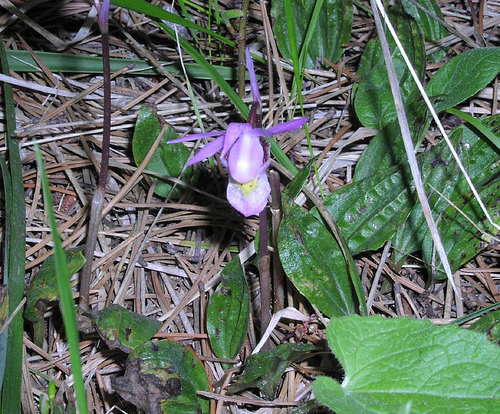
Calypso bulbosa, Calypso orchid
(*photo credit)
July 4, 2008 Declare Resource Interdependence
In the course of human events one nation and people become so affluent that they can become a superpower, can overlook the poor of other parts of the world, can consider only their own so-called umbrella of defense, can spend more on the military than all other nations combined, and can consume non-renewable resources at rates far exceeding anything ever conceived in the history of the world (until a newly middle class China entered the picture).
But should that nation glory in its power and call it "independence"?
Today is a perfect time to regard our desire to be self-sustaining and yet not isolationist and removed from an interdependence that is needed by all people of good will. Should the rest of the Earth be drained of resources to keep affluent "independent" American (or other nations') affluent lifestyles flourishing? If we depend on others to furnish our "needs," which are often excessive, we are being deprived of our true self-sufficiency. Dependence on foreign petroleum resources is to surrender independence for the sake of our addictive behavior. In many ways current energy conditions threaten us as much as the oppressive policies of George III did our founding parents, who were taxed without their representation.
With respect to world resources we declare that ...
* We must become self-sufficient in all bulk materials such as food and energy.
We will strive through the use of wind, solar, geothermal and other safe renewable energy sources to reestablish our energy independence;
* We will assist other poorer nations to improve their own infrastructure so that at best they can become self-sustaining in food, fuel and other essential resources;
* We will conserve our resources: insulate our homes, drive more energy-efficient cars and trucks, stop the frivolous waste of energy on everything from excessive air conditioning to ornamental lighting, find ways to cut back still further on electric appliance wastes and reduce the need for excessive space. We will conserve reserves of petroleum for future medicinal and other vital petrochemical needs;
* We will reinvest money now spent on foreign fuel to improve our own national infrastructure and assist in alleviating world poverty that renders our country more insecure;
and
* We must become interdependent by encouraging all nations to become more self-sufficient and by accepting a joint responsibility to share excess resources with the needy in other lands.
Prayer: Lord teach us the difference between an unhealthy dependence on others and a healthy self-sustainability in use of local resources. At the same time help us see our responsibility to become interdependent in the world community of nations.
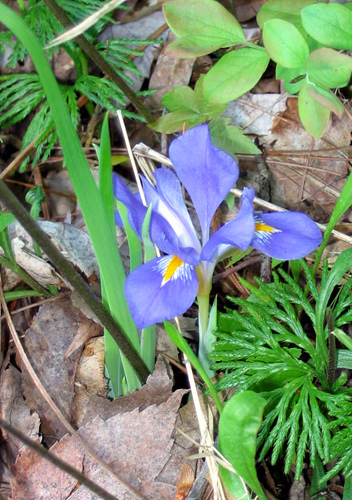
Iris verna, dwarf iris
(*photo credit)
July 5, 2008 Care for Our Heart
Certain foods in excess affect our heart and some overlooked foods can become an integral part of proper heart care. The word is already out -- no smoking, no drugs, no extra stress, plenty of exercise, weight reduction and no excessive drinking. Fine, but if we did all these things, we could still have heart trouble because of stressful circumstances, or weak genes, or some other combination of reasons we have never fathomed. We know that we must take care, but there are factors in this cluttered, fat- filled, busy world that are almost beyond our control.
Four years ago I had an angiogram, the first such hospital test in my life, and I followed on the TV screen the probing tube up the artery to the heart. A nurse asked (after the doctor had left the room) whether I had ever smoked. In surprise I said "yes," but I quit eighteen years ago.
"Well," she said, "I have seen many hearts, and know the heart of a smoker." Such a comment made me pause. Yes, the smoking habit had left an imprint on this imperfect heart of mine. I had complications and chest pains but maybe medication and great care of diet could help. Doing all the right things includes the right foods -- the fresh fruit and vegetables, the fat-free milk products, the right kind of cooking oil, and the elimination of greasy fast foods.
Certainly in this twenty-first century we have become more concerned about heart disease and its relationship to food as well as to increased physical activity and reduced weight. We are told that certain foods and supplements help influence the total cholesterol in the blood, in which there are a bad component (LDL) and a good one (HDL); the former can be reduced by certain medicines; the latter should have a number higher than 40. Boosting HDL cholesterol can be achieved by eating such foods as macadamia nuts and English walnuts, barley, avocados and rice-bran oil not all of which are easily obtainable. Also doctors may recommend the supplement niacin though it can have unpleasant side effects (an apparent over-heating situation). Another food approach involves balancing the types of ingested fats. The spread Smart Balance and similar mixes contain a balanced portion of certain vegetable oils (palm fruit, soybean, canola and olive oil), but no hydrogenated oil or trans fatty acids
A healthy beating heart is essential to life. We can speak of a bleeding heart or hearts that are hard or soft, aching, loving, tender, or searching. How about our beating heart? The heart has been known as the seat of emotions. When that heart, which so defines who we are, fails or sputters for even a brief moment, the emergency people come running. Their care is certainly heart-felt.
Prayer: Lord, make us aware of the condition of the heart within us, for this organ is essential to our mortal life, our mobility, our service, and our way of living in this world as instruments of your love.

Squaw root, Conopholis americana
(*photo credit)
July 6, 2008 Overcoming Terrorism through Loving Service
Come to me for I am meek and humble of Heart. (Matthew)
Many people have difficulty sleeping at night; this can be due to a number of factors, including worry, stress or even a certain sense of insecurity. Fear stalks many long after they have experienced some traumatic event -- an attack, a theft, a sudden death, a flood, a fire, and on and on. When will another episode occur? Will it involve me or some of my loved ones? How can we live in fidelity to our calling when we have to face the realities of what President Bush calls the "War on Terrorism?" Do we wait the next terrorist shoe to fall? Is it possible to go beyond these immediate dangers and help reduce terrorism by bringing peace and justice to our world? Can we find security in a spiritual
outlook?
Among memorable events, 9-11 stands out, and many of us Americans remember exactly where we were when we found out about the event. We could not believe our ears and eyes as those unsuspected terrorists successfully brought down the twin World Trade Towers on September 11, 2001 -- and succeeded in attacking the Pentagon as well. Yes, some people really did hate America and its military power and other things typical of our culture. The 9-11 attacks surprised us Americans who have regarded our culture as enlightened, blessed, democratically-controlled and a model that the rest of the world wants to
imitate.
Granted, we consume a quarter of the world's resources with 6% of the world's population, but until 9-11 that was regarded as our privilege. We had come to expect others to use the English language, THE global language. We considered ourselves leaders in everything from medicine to high technology. We thought the whole world loved us as much as we did ourselves, our democratic traditions, and our place in a globalized world. But we were unprepared for the rude awakening. Moslem extreme fundamentalists expressed profound dislike for us and what we stand for, perceiving us as materialistic and godless -- and as successfully spreading our message to others. The 9-11 event proved this dislike.
We need now to focus on something else -- a gospel of love, a sensitivity to the meek and humble -- and we can only do this by being in solidarity with others, and that is expressed through an attitude of loving meekness. St. Paul speaks about us being patient, kind, not jealous nor pompous, not inflated nor rude; this love seeks the public interest; it rejoices in the truth; it is both radical and gentle, that is, getting to the roots of problems and acting gently. We are committed to witnessing to the ultimate victory of love over hate. A message of love is not the loudest, the most militaristic or the most economically
successful.
Prayer: Lord help us to return to a culture of loving concern for others, to abandon any form of arrogance and materialistic "progress;" help us discern truth, not false propaganda, to depend on You for security, and to strive to help all who are in need.
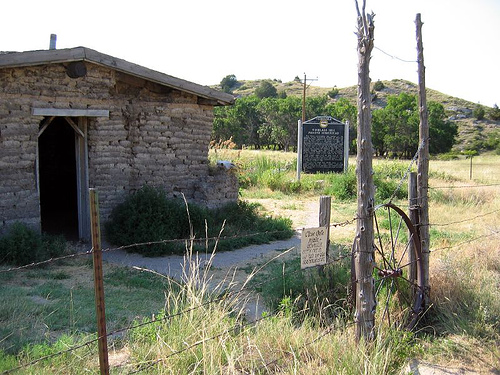
Windlas Hill, sod house - pioneer homestead in Nebraska
(*photo credit)
July 7, 2008 Local Food Distribution Systems
People are coming to know that higher food prices and growing scarcity mean that some have the resources to purchase the more costly food commodities and others do not -- thus the riots in poorer
countries. America is not in such dire circumstances at this time, but scarcity is being felt here as well as elsewhere. I serve an Appalachian county with a 23% of population poverty rate and high drug use and overdosing. As one might expect, some of our residents run low on food, especially at the end of each month. The conventional food sources often run short of food supplies.
American government's (federal, state and local) food sources are generally available.
Our greatest source is food stamps that those with low income can receive. The use of a personal coded card has reduced abuse of this program.
One of the difficulties is that these stamps can be used for a wide variety of food and even soft drinks by people unfamiliar with the dangers of excessive junk food. A more specific government program is WIC (Women, Infants and Children), which provides food, health care referrals and nutrition education to low income pregnant, breast-feeding and post-partem women as well as infants and children up to age five who are found to be in nutritional need. A third government distribution program (when more food surpluses are available) is the federal commodities program that has dispensed peanut butter, cheese and other nutritious commodities to those who qualified; this program is now hard pressed due to lack of food surpluses.
Non-profit organizations have sought to fill in the cracks. Direct
money handouts have been discouraged and are not now a popular means due to misuse by those who suffer from substance abuse. A better direct approach is the retail card that is sold by various food supermarkets; these can be used by the recipient in a more or less unrestricted manner depending on buyers' choices (and include gasoline at associated fuel stations). Cards are open to misuse.
Garden produce and other food surpluses such as wildlife from hunts are available at various times of the year. Sharing these with people who are in immediate need or who can preserve the surplus in some fashion is ideal for reducing hunger. Unfortunately, this is quite seasonal and does not necessarily mean that the surplus reaches those in greatest
need. Second Harvest programs are available in some places; these groups identify outlets for slightly outdated and unsold perishable foods and collect and distribute these materials to the homeless and lower income people. Again, the program depends on hit-and-miss
conditions. Meals-on-wheels distribute, prepared dinners to the sick and elderly. Churches and other institutions give food baskets at Thanksgiving and Christmas. Finally, some organizations and networks gather basic commodity surpluses for the
needy.
Prayer: Lord, allow us to be sensitive enough to see the hungry and support methods of getting food to those who need
it.

Prairie dog, North Dakota
(*photo credit)
July 8, 2008 Lakes and Aquaculture
Lakes are major assets to property and can be excellent examples of land/water harmony and environmental balance. They can be quite productive food sources as they provide fresh fish for domestic consumption or sale; they can furnish water for irrigation, boating and other recreational activities, provide fire protection for nearby buildings, and replenish the water table. Lakes may increase the economic value of land. New lakes require planning and consultation with soil conservation people, in regard to the size and best site on which to build and the type of lake floor liner to apply. Former requirements for clay lining are not as urgent today when builders can add heavy-duty plastic liners that appear to work quite well when properly installed.
Aquaculture: Fresh fish is generally considered superior in nutrition to more expensive and resource-intensive red meat. Some lake holders who find it difficult to actually care for fish can find neighbors who will accept the opportunity, even in return for sharing the produce on a percentage basis.
This important food source demands far less attention than other comparable protein sources. In fact, bounty may become a problem as owners may be overwhelmed with fresh fish. Overabundance allows for sharing with the needy and to preserve the surplus by freezing. Aquaculture has proven to be an excellent way to increase a community's self-sufficiency and yield supplemental income.
Watershed control:
Owners of existing or proposed lakes need to understand the limits of their watershed. If the property holder controls all of the watershed of the particular lake, there are no major worries. If the water is fed from urban, suburban, or rural landscapes where the input of chemicals into the water is not controlled, then the lake obviously has limited value as a producer of fish for food. For fish production, it is best to have either complete control of the watershed or a formal compact with others within the watershed to refrain from using on their land pesticides and other chemicals that could contaminate the lake.
Recreational assets:
Lakes are very inviting and enticing. All like to boat or swim in a nearby beautiful body of water in summer or to skate on a frozen lake in winter. But through mishaps, lakes can easily become liabilities for owners. The uninvited often grasp the recreational benefits faster than property holders. Controlling access and protection soon becomes a challenge. Thus the best suggestion is to place a lake close to a residence in order to dissuade the uninvited.
Vegetation: A wide variety of plants can enhance a lake's beauty and supplement fish feeding needs. Wetland plants are well suited for lake shores, and trees such as willow and mulberry can add beauty as well.
Prayer: Much of Jesus' teaching was given near or on the Lake of Galilee.
Help us to teach the benefits of lakes today.
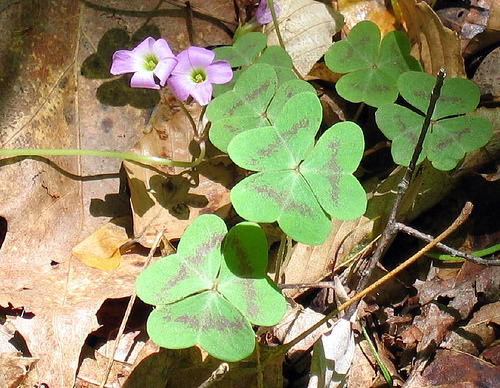
Violet wood-sorrel, Oxalis violacea
(*photo credit)
July 9, 2008 Vacation Time and Eating
When we travel, we often relax our eating habits. We consume more fatty food by eating out, and especially by frequenting fast food restaurants for breakfasts, lunches and even dinners. When we move about these places, we forget that we were going easy on the deep fried stuff, the meat dishes and hamburgers and all the potato chips and sweet snacks that we carry along for the trip. And there is the excuse that we need to be moving and so we frequent the drive-through or we need the extra caffeine from the rather expensive and over-sized soft drinks available at rest
stops.
Perhaps the real test comes when hunger builds up after an active day and the "all you can eat" smorgasbord looms before us. The usual nagging feeling is suppressed and the nagging person is absent, and so eat your heart out -- for we have already paid for it and we deserve to get our money's worth. The first plate does not cover all the delicacies, and so the second involves all the "sin" foods that are so tempting at this time. So much for the resolutions that are suspect at vacation time. Before starting the trip let's consider some suggestions:
* When travelling by auto take along lunch food in a cooler;
* Prepare for the travel hunger pangs by bringing along snacks that are more healthy and lower priced: fruit of all varieties, cut veggies (e.g., celery and carrots, nuts of various sorts, plain taco chips, popcorn with your own herbal flavoring, etc.);
* Frequent a respectable "mom and pop" restaurant on occasion. The food prices will be reasonable and the selections of home-cooked meals will allow things that are quite nutritious.
Often these places prove very reasonable for breakfasts, America's meal with the best bargain prices;
* Regulate the day by eating only two regular meals and some wholesome snacks in between. Rising later and lacking the stress of everyday life, means that a brunch and evening supper could prove economical, or maybe a big bargain breakfast and one other meal. Plan on fewer of those gigantic meals for you will appreciate doing so after vacation;
* Carry along water and healthy drinks so that you can regulate what is consumed without giving in to the expensive soft drinks that are quite costly and harder on you;
and
* Have your own picnic/cook-out in a scenic location when time allows. This could prove more enjoyable than a crowded restaurant with the waiting time that causes some to endure the pains of hunger before being seated.
Prayer: Lord show me how to relax and enjoy myself during this rest time and still do so in ways that I will not regret later. Help us live our resolutions and enjoy doing so.
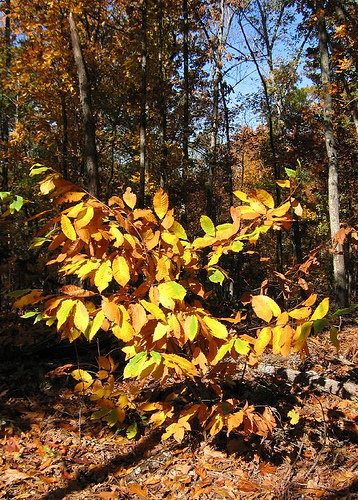
A young American chestnut, Castanea dentata
(*photo credit)
July 10, 2008 Chestnut Memories: A Wake and Reawakening
The American chestnut forest, a principal source of mast for wildlife and supplement for pioneers, was devastated in the early twentieth century by an unexpected blight; now it awaits a new life as a natural food source for humans and wildlife
alike.
My siblings and I have vivid memories of the large American chestnut snag, over three feet in diameter and ten feet tall, which stood as a gray white monument on our family farm's boundary line with our Uncle Pete's place in Mason County, Kentucky. Although both my dad and uncle were very tidy farmers, throughout the 1930s and 1940s they deliberately allowed that large tree trunk to stand as a memorial. Even more mysterious to us as youth was that it was surrounded by littered ashen gray branches and tree parts, which simply did not rot. We were too young to comprehend what species the "Big Tree" was, only that our grieving forbearers never cleaned up the littered pieces of wood, which seemed never to decay. Once we brought a chunk of that wood into the tobacco stripping room and Daddy told us to take it back, as though it was a family heirloom; he liked trees and carved with wood in retirement.
The "Big Tree" was several hundred years old and was most likely seen and its shade used as a resting place by the pioneer Simon Kenton, a friend of Daniel Boone (who claimed 10,000 acres, which most likely included this particular tract of land). Kenton spoke of staying at the "cane brakes" in the headwaters of Limestone Creek near Old Washington, Kentucky, and in our immediate neighborhood. He mentioned a strong spring of water, and that spring remains flowing today in good times and through drought.
A likely place for his visit was near the "Big Tree."
During the 1880s my maternal great-grandparents, the Louis Schumacher family, lived on part of the original General Henry Lee Estate, on which "The Big Tree" stood. As a youth I recall my grandfather telling us kids how he had to go get a cow having a calf and found both animals under "The Big Tree," a half mile from his home. Again, the tree fitted into events in our family history, but the type of tree was outside of our experience as youth, for all the chestnuts had died. Only years later, when hiking in the newly established Blanton Forest Reserve in Harlan County, Kentucky, an experienced forester pointed out the unrotted stump and parts of an old American chestnut grove. This debris had the same color, texture and weight as the unrotted pieces we knew as youngsters in Mason County.
Then the insight! That was why the dead snag was tolerated at our family farm. The unrotted pieces were parts of a respected dead but not yet cremated American chestnut. Today, through selective propagation and regeneration techniques, the American chestnut is ready to make a comeback both in unreclaimed strip mine lands and through its traditional growing area. Visit the American Chestnut Foundation
<acf.org>
Prayer: Lord, teach us to help resurrect what has been gravely damaged and to give new life to what is threatened.

Cooling it!
(*photo credit)
July 11, 2008 Eleven Reasons for Locally Grown Food
1. Spirituality: Natural growth processes generate rhythms of the soul. We are spiritually uplifted in growing our own food.
2. Resources: Energy savings result from raising home-grown produce in contrast to factory farming and transporting of food.
3. Personal Control: Gardening allows control of contaminants on the produce and to understand that home-grown food is wholesome and safe. It becomes an opportunity to grow organic produce.
4. Environment: Reduces dependence on factory farming or other harmful growing practices in the production of the community's food. Eating local produce helps avoid damaging land fertility and the environment, provided good cultivation practices are used.
5. Labor Practices: Home growers have better control of labor practices at all stages of food production and preparation. Consider the exploitation of migrant farm workers, who are often expected to work without adequate protection against agricultural poisons and without proper housing conditions.
6. Aesthetics: Beautify the countryside and make it a better place to live for all residents. One is able to construct the garden landscape artistically through the choice of plants, the timing of maturation and the specific placement of each vegetable.
7. Eco-justice: Make a powerful political statement of social justice/eco‑justice through gardening. We will not buy products unless we are sure that workers receive a just wage.
8. Health: Obvious health benefits occur to all including older people who get outside exercise and fresh air when gardening. A sense of well-being and control over one's life comes from self-sustenance and the resulting improved health.
9. Savings: Economic benefits result from growing one's own nutritious foods and sharing them with others in the vicinity. We are experiencing rapidly inflating food prices. At a time of inflated food prices savings accrue by growing one's own food.
10. Psychology: In growing our own food we can take control over our own lives and gain an added measure of self-respect. We provide for ourselves and break the total dependence on others for our food needs -- and this encourages us to take other actions.
11. Model: We show others in the local area what they likewise can do to become self-sustaining through gardening. People tend to imitate those who are neighbors and find that learning about gardening are less threatening if teachers are familiar to them.
Prayer: Lord, teach us to value what we can do when touching the soil and growing our foods; help us see this as a valuable way to heal our wounded Earth.

Ft. McPherson, Nebraska, old mobile home reused as office for tent campground, decorated with neatly potted flowers
(*photo credit)
July 12, 2008 Championing Quality Amid Food Shortages
High summer is quality time, and we know what that means with its pleasant scents and sights and tastes. It is the time to stop at mid-year and reflect on the tripod of good gardening, i.e., local taste and fresh quality, nutritional content and productive yields. Through choice of specific cultivars within the vegetable groups (along with proper harvesting, preserving and cooking) we can preserve tastes that please the palate; through careful selection of crops good nutritional content can be secured; and through raised beds, interplanting and other intensive techniques the quality-minded gardener can obtain plentiful
yields.
Current mass produced vegetables involve picking hybridized unripe produce, shipping for long distances in refrigerated units, using artificial ripening agents, and selling in a supermarket chain. The nutritional value of such commercial produce is limited when it is harvested before ripening, for vitamins and other components do not have time to develop. Commercial producers desire products that are perfect in appearance, that is, free from blemishes, without regard to chemical pesticide presence or nutritional content loss. Chemical-free commercial produce is not easily found under such conditions and is higher priced. A wormy apple may be unappetizing but it may indicate the absence of pesticides. One of my finicky aunts accepted worms on or in produce, calling them signs of chemically-free conditions and, if accidentally cooked, a source of protein.
Today, many engage in higher-quality lifestyle practices such as smaller vehicles, less spacious homes, less fashionable clothing, more time with family (down-sizing job expectations), growing and purchasing locally-grown organic foods (nutritional quality), and more time given to the arts and music. In a world of shortages of all types we emphasize obtaining bulk products (materials that are needed in large quantity) -- food, water, building materials and energy supplies -- from sources close at hand where quality is controlled and transportation costs reduced.
Higher quality grains, fruits, vegetables, and herbs allow for a more balanced and wholesome diet that uses less resource- intensive food. This quality diet means less use of resource- intensive domestic animal products by everyone.
Unit-for-unit, the meat-, milk- and egg-producing domestic animal is a consuming agent, requiring considerable feed to stay alive, reproduce and furnish animal products for human consumption. Much grain is required for conversion to the final animal product that is ultimately consumed. Grain-fed beef is at the highest end of this intensity scale, with pork middling and poultry and fish at the lower end of the scale. Animal feed (corn, other grains, hay, soybean byproducts, and even pastures) takes up prime farmland that could be used for basic food staples for export.
Prayer: Lord, teach us to champion quality while sharing with others; help us to become conscious of the need for low-cost, nutritious, and locally-grown food for all in this hungry world.

Abraham Lincoln's Springfield home.
(Photo by Mark Spencer)
July 13, 2008 Sowing Good Seed
Just as from the heavens the rain and snow come down
And do not return there till they have watered the earth,
making it fertile and fruitful,
Giving seed to those who sow and bread to those who eat,
So shall my word be that goes forth from my mouth;
It shall not return to me void, but shall do my will
achieving the end for which I sent it.
(Isaiah 56: 10-11)
We need to see the connection between the fruitfulness of Earth and the fruitfulness of word. Jesus likens sowing and the falling of seed on various places with the fruitfulness of word.
This word (Good News) is spoken by us as a people, the Body of Christ. How does spreading Good News enter into our emerging sense of the news of increasing hunger in the world especially among an estimated one hundred million including many vulnerable infants and pregnant women. The Good News is of several types: the fact that the commons belongs to all and not just to the privileged few; the news that we must help share the gifts given; and the news that we can solve the food crisis.
1. Food is not an option that can be stored or used by a chosen and fortunate few. With proper and available technological facilities we can gather, store, ship and redistribute the food that could be easily wasted or misused -- and the power of the moral dimension of word is that resources belong to all -- especially those who hunger.
2. We Christians believe in the power of the word. Jesus shows this power emerging in the long story of the Old Testament, the power of the prophets of old, the force that moved John the Baptist to go into the wilderness in order to call people to correcting their ways, the announcement of the Kingdom and the teaching of it in the Gospels by Jesus, the coming of the Holy Spirit and the touching of fearful individuals making them the proclaimers of the Good News. Those good words were summarized in quite succinct and emphatic form and touched the ears of recipients who rose up to follow the prompting of the Spirit in their own lives. The word has power.
3. We can do it. If we believe in the continuity of the Good News today, we have taken on the role of sower of seed as Jesus tells us (Matthew 13: 1-23). Today this word needs to be spoken out of justice for our individual and collective salvation. Our faith extends beyond belief that God will do miracles; our faith includes the power for us to act as a confirming sign of the Spirit empowering us here and now. Yes, we are empowered to speak the truth and allow that word to fall on fertile ground and can transform barrenness into fertility.
Prayer: Lord help us to understand the power of the word we can speak, the deeds we can incite, and the success we can achieve when we inspire and encourage others to share your bounty.

Bog habitat, Wyoming
(*photo credit)
July 14, 2008
Agribusiness
We need only look back fifty years when many family farms flourished in our country and entire families were engaged in keeping the local economy going.
Today, a comparatively small number of homesteaders and sustainable farmers are able to continue these practices even amid economic roadblocks. These barriers could be overcome if governmental benefits and support were more equally divided in the agricultural sector that has for too long been dominated by the politically powerful. We are currently beset by the demand for high quality food in sufficient quantity to feed the world's hungry. Quo Vadis? Will we take the agribusiness route or can individual small-time farmers
contribute?
Citizens are aware of, but have not yet addressed, the cruel manner of large-scale livestock production ranging from massive cattle and hog feedlots to crowded buildings for raising chickens and turkeys. While major portions of the farm economy such as bulk commodities production are dominated by agribusiness, still there are expanding horizons for the entrepreneur, especially in specialty, organic and local crop production. Such farmers could produce animal products in more humane ways.
Today, increasing portions of American livestock farming involve contracts with food-related corporations. The problems related to contract agriculture were explained in Update, the bulletin for the National Campaign for Sustainable Agriculture (June, 2001). Each year a higher percentage of agricultural commodities are produced through contract with vertically integrated agribusiness (35% in 1998, and increasing at about 1% per year) starting with poultry in the 1950s and expanding to many major commodities -- beef, hogs, fruit, vegetables, and tobacco. Unless reversed by such methods as local Freedom Gardens and community growing practices, small-time farming, confronted by corporate giants, has a bleak outlook . The result is a growing inequality between producers and marketers/processors. Can contract farmers regain control over their
lives?
Coalitions of public interest groups advocate policies to help small farmers achieve fairness and establish minimum standards for agricultural contracts and reasonable government oversight. For example, the Agricultural Fair Practices Act must protect the ability of farmers to negotiate fair contracts with processors. Furthermore, the federal government must have authority to halt unfair trade practices. Turning from independent to contract farming bodes badly for a traditional family-based agriculture, especially when competing in the production and sales of major agricultural commodities. Regaining control over our people's lives means getting a proper method for handling contracts so as to benefit all. Finally, farm subsidies to American corporate farmers should be halted so as to benefit farmers in developing countries.
Prayer: Lord, give us the strength to confront unfair agricultural policy so that the hungry of the world may benefit from more plentiful and lower-cost food.

Tulip poplar flower and leaf, Liriodendron tulipifera
(*photo credit)
July 15, 2008
Freedom Gardens: Individual Actions
During the Second World War, Americans were encouraged to enter the "war" effort by growing their own produce. This practice was promoted to free laborer-short farmers to produce surplus materials that could be sent overseas to feed highly stressed Great Britain and for the service personnel that were engaged in the war effort. "Victory Gardens" became the rage and before the war ended there were some thirty million of them -- some highly productive and some heroic ventures by urban folks with small amounts of space to grow vegetables.
The effort became a national crusade and along with home canning at converted school cafeteria and kitchens during vacation months, it resulted in public participation by many.
Today, we have good reasons to strive for Freedom Gardens: we would supply plentiful, nutritious, low-cost food so that we could free up produce that would otherwise be consumed in America to be exported (in the form of root crops, grain and edible oil-bearing materials); our people could become more conscious of the effort it takes to produce food and could have an opportunity to touch and come close to the soil. Much of the land is now in lawn, which consumes about one-seventh of our energy-intensive fertilizer plus the fuel needed by motorized lawn-care instruments (it takes less non-renewable energy to cultivate gardens than to manicure lawns); the locally grown produce would mean that energy for transporting food an average of 600 miles away could be saved;
neighbors could be encouraged to do similar things and through community give-and-take learn how to garden under less stressful conditions (embarrassment is often a stumbling block); and the beauty of variety gardens over monolithic landscape could be actualized.
The major advantage of more food, especially grown on once prime farmland-turned-suburban-residence, should not be overlooked. Many concerned environmentally conscious people talk about "farming on the edge" and mean the encroachment of development on otherwise large tracts of farmland in every state of our country. For them the future of the world's bread basket looks somewhat dire. But there can be a reversal of roles, not just the infrequent and somewhat expensive turning of roofs into gardens (it can be done) but the use of space around buildings and the vacant lands now in need of restoration. Freedom gardens may not only produce a multitude of harvest crops; they may require adapting creative ways to preserve the surplus (see next section). The freedom garden may spawn the need to extend seasonal growth methods (cold frames, berming, greenhouses) to enhance production into the late part of the year; they may encourage the construction of freedom lakes (July 8) to grow fish; and they may inspire the conversion of cultivated land into edible landscapes through use of perennials.
Prayer: Lord, you placed our first parents into a garden and gave to all of us the love of cultivated space. When the human race became numerous, we learned to sustain ourselves through our human toil. Inspire us to turn unused landscape into food-producing areas and to work on the individual level to grow our needed food so that we can share more with those who hunger.
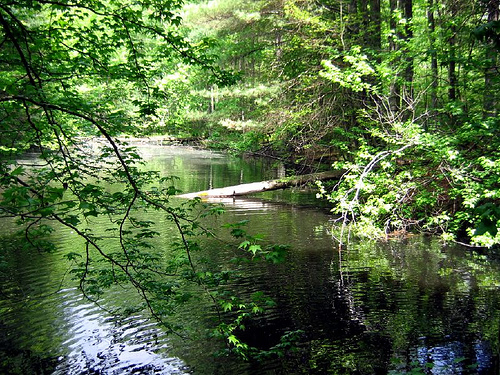
Lily's Pond. Daniel Boone National Forest, near Stanton, KY
(*photo credit)
July
16, 2008
Community Gardens: Group Activities
A Freedom Garden can go beyond being an individual enterprise involving a backyard. Some people lack individual surplus land or prefer to garden with others in a community. Fine. Their gardening could take on a community character and generally involve a piece of land divided into designated plots that are distributed to various individual gardeners. A less popular approach that could work well with a school class or similar group is to garden collectively on an undesignated plot. The advantages of Community Freedom Gardens are obvious: people can work and get to know others; they can more easily learn gardening techniques in a non-threatening manner; and they can exchange and share produce with other producers as well as the needy in the vicinity.
Communities gardens could include such unused land as:
* institutional surplus lands and lawns;
* unused portions of cemeteries;
* development areas prior to construction;
* flood plains and some conservation lands;
* refurbished and resurfaced brown fields;
* agricultural lands not presently being farmed;
* areas adjacent to parks and roadways; and
* vacant lots adjacent to homes and housing developments.
Community garden success depends on how the community garden is organized. It takes some up-front planning and careful laying down of ground rules, which can both encourage the serious gardener and discourage the one who will quickly abandon the project as hot weather sets in. Abandoned community garden plots can litter the countryside, when they are not properly supervised. A strong supervisor separates the real gardeners from dreamers and encourages the wayward to continue. Once the right supervisor or coordinator is found, ground rules can be established. "Don't grow mole beans, because children may be tempted to eat the poisonous beans." "Don't overly shade a neighbor's plot." "Don't expect your vines to trespass without permission and sharing of the produce." "Share water sources."
One approach to community gardens is to plow or cultivate the entire tract each year and then allot the plots afterwards. The other method is to lease individual plots, which may contain perennials (e.g., raspberries, horseradish, Jerusalem artichokes, or comfrey) from a previous year's planting. These perennials permit gardeners to plan their work for a longer time and to acquire a sense of ownership of a plot. A community garden does not necessarily have to be chemical pesticide-free, but it is virtually impossible to keep some adjacent plots "organic" when others are not. The wind blows, and water run-off cannot be easily controlled. One solution is to declare the entire plot as organic and distribute information for keeping it that
way.
Prayer: Lord, teach us to see gardens as a community enterprise for it demonstrates the community of all being. Then we will begin to share resources within a global community.

After a cooling rain
(*photo credit)
July 17, 2008
Food Preserving Techniques
With growing food shortages, during July we ought to think about preserving food surpluses for the non-growing parts of the year. How do we preserve high-quality leftover produce such as beans, brassicas, cucumbers, zucchini and tomatoes? Can we go beyond stuffing ourselves with vegetables in plentiful supply and sharing with immediate neighbors? From the times of our distant ancestors, foresighted folks thought ahead to the non-growing colder season.
They dried, stored in the ground (less susceptible to theft and confiscation) or preserved foods through salting, canning or by other ingenious means. We admire and seek to imitate their foresightedness and ingenuity. Their goal was the same as ours today: save the flavor and quality while retaining produce, which will satisfy hunger in times of want. Can we resuscitate and improve on some of these past practices?
Root Cellars are a tried and true manner of preserving many vegetables and fruits. These storage places are partly or totally submerged outer buildings or interior space. They are dark and cool places at constant temperature and controlled humidity where produce could be preserved for at least six months in order to meet the needs of the winter months. Besides potatoes and virtually all the root crops, such places are perfect for storing winter squash, pumpkins, brassicas, apples, pears, and even wrapped tomatoes.
Canning of fruit, berries and vegetables takes great effort in the heat of summer but the products taste great in winter. What sacrifices were made for materials and flavor in the past! I can recall my mother making such great sacrifices and being so proud of the materials she canned. She would take visitors to view the fruit of her labor and to enjoy the colorful and tasty food.
Solar drying (see tomorrow's reflection)
Pickling has been around as long as common salt has been accessible. The curing of hams and other meats through the salting process dates back to Celtic hams being transported to Roman overlords almost two millennia ago. Besides meat and fish, the salting or "pickling" process extends to cabbage (sauerkraut), cucumbers, turnips, watermelon rinds, and many others vegetables.
Freezing produce is a convenient food preserving method, but generally uses non-renewable energy to operate. Some products such as beans do not fare well through freezing, but the method works well for corn, peas, tomatoes, cherries, berries and many fruits.
Leaving root crops and other vegetables in the garden is the simplest preservation method in temperate areas. The time left in the garden depends on winter severity and on the protective cover. In
Kentucky, carrots, Japanese radishes, Jerusalem artichokes and turnips can be left in the ground. Likewise, mustard, kale, and collards will stay fresh, if protected from wind and intense cold.
Prayer: Lord, help us preserve surplus food for future needs.

Soaking up the sun
(*photo credit)
July 18, 2008 Solar Food Drying
Solar food drying is not new, for we are familiar with dried raisins, apricots and prunes. Solar food drying does not have to be reinvented, only rediscovered as a major food preserving technique for apples and other low-moisture content fruits and vegetables -- even if dried an in an old automobile or
attic.
Specific solar dryers can be made from scratch or purchased, and permit a current of solar-warmed air to flow over porous screened trays of cut fruit or vegetables, protected from direct sunlight. Different lengths of time are required depending on moisture content and on the local humidity. Efficient devices ensure good air-flow, moisture removal and sufficient warmth (about 110 degrees Fahrenheit) during the process. This is especially important in areas with relative humidity of 70% or higher on an annual average. A variety of commercial and low-cost build-your-own food dryers are available. For solar drying the sun should not shine directly on the produce, otherwise it will reduce the nutrient content. The solar dryer's flow of heated air will carry off the moisture; heated air passes through a duct over a dark- colored collector surface with greater efficiency when the surface is exposed to maximum sunlight. Some operators prefer to swivel the dryer and follow the sun. Screens should be installed over the air openings and exhausts to exclude
insects.
Solar dried foods retain their nutritional content better than some cooked and preserved foods because the temperature range for the drying is less than temperatures used for canning. Solar drying uses renewable energy from the sun and the fuel is free; with some basic familiarity the process is quite straight forward; drying reduces volume and allows for easy storage (no deep freeze costs) and transport, especially for backpackers; it is readily available for consuming and has few spoilage problems.
With a good food dryer and with the proper weather conditions, one can dry almost any type of food. It is easier to dry an apple than a tomato with all its juice, but tomato "leathers" can be prepared under special conditions though best in desert climates. For more humid climates, limit food drying to low moisture-content produce -- apples, pears, onions, carrots, rhubarb, turnips, pumpkins, cauliflower, beans, broccoli, corn, squash, mint, bay leaves, dill, garlic, peppers, ginseng root or leaves, basil, parsley, and many other herbs. Select good produce which is not overripe but rather just ready to eat. Start drying it the day it is picked. Some people blanch (hot water or steam) food for a short time before drying to preserve color and texture. Place the food in the solar dryer on a natural or artificial fiber (not metallic) shelf mat and, if not thoroughly dried by sunset, close it off, so that night moisture will not penetrate the drying produce. When dried to the desired degree, remove and store in a cool, dark, dry place. The dried material is prepared by reconstituting with water.
Prayer: Lord, inspire us to preserve the gift of our food.
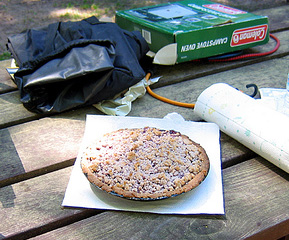
Thimbleberry pie, a vacationer's treat
(*photo credit)
July 19, 2008 Food Marketing and Cooperatives
Some small-time gardeners want to make a living by producing food commodities, and others want to supplement their income by the sale of surplus produce. The target market is quite important for them as well as the hope that they can grow something that has a demand. Some as members of my farm family would peddle
butter, strawberries, plums and other surpluses. Some individual producers prefer to bring a quantity of the fruit of their labor to
a farmers' market; this does not require the responsibility of providing set amounts of produce to individual customers or retail marketers. However, this approach depends on the hit and miss of individual marketing -- and often others have the same
surpluses.
Another marketing approach is designed for those seeking to make a total living out of gardening; this is the "CSA" or Community Supported Agriculture.
Usually this consists of receiving a determined sum of money from a customer (some perhaps up front) with an understanding that a basket or fresh produce will be delivered by the producer on a periodic (often weekly) basis. The guarantee means that the grower needs to think ahead of a variety of vegetables and herbs that will produce results on a regular basis for those who are consumers. The success of CSAs depends on the weather, the planning and hard work.
A third approach is to deal with food wholesalers and processors. One approach is through marketing cooperatives. Food marketing coops require planning, standards, type of material, grading of the produce, and determined sales destination. The agricultural commodity determines the nature of the marketing coop. My folks were members of a tobacco coop; as prices rose, more growers got into the act; when prices fell, some were hurt due to overproduction.
Therefore a tobacco marketing coop controlled production so all would benefit.
Annual vegetable crops can be the commodity of choice but overproduction can be detrimental to the enterprise. However, a medicinal herb, wild ginseng, has a market (now selling at over $800 a pound fresh); it grows slowly and takes over a dozen years to mature but is subject to theft if the location is known.
Most vegetables and herbs are not of such high market value as tobacco or ginseng; they are more subject to price fluctuations and uncertain marketing of perishable produce. Creating a marketing cooperative takes a public organizing effort, but this could be opposed by those, such as ginseng growers and gatherers, who prefer secrecy for security purposes. Marketing of milk products, grain and fruit can be used to minimize competition among producers.
Union and guild members testify to the power in organizing. Cooperative success depends in part on the commodity; tobacco coops were healthy although the product's use was not; this material accrued in value after harvest; on the other hand, fresh produce is generally perishable and must move quickly to market.
Prayer: Lord, help each producer discover the best means to get materials from place of production to those in need.

Unidentified mushrooms growing on stump, Cumberland Gap National Historical Park
(*photo credit)
July 20, 2008 Weeds, Tolerance and Permissiveness
And you taught your people, by these deeds, that those who are just must be kind. (Wisdom 13:19)
We continue today the agrarian motifs used by Jesus in his parables in Matthew 13. We need not be grain growers to understand the parables however, for we know today to what extent weeds can choke the cultivated areas we have.
However, secret weed sowers seek to entice others to agree, to consume as they do, and to succeed by going along with the crowd on whom they have considerable influence. The weeds become the consumption habits that come to play in our world and crowd out the essentials that are needed to keep all and especially the poor alive. Weeds then become the luxuries that some have and others do not, but for us to overly separate and root these out could create a major disorder in our social system. In what way should we "tolerate" the misspent luxuries in our midst, while five thousand kids die each day from lack of proper nutrition to ward off opportunistic
diseases?
Tolerance may be used in different ways but it may be confused with permissiveness. A parent who allows one child to beat up on another is not tolerant; that is crass indifference or neglect. If the tolerance is to allow some secret "weeds" to draw the attention and entice others, it raises questions. To what extent must we have forbearance and be patient with our fellow human beings, even when they are overly weedy in their lifestyle and practices. To weed enticements out severely is a form of intolerance that has proven quite cruel in past history and has no place in a modern democratic society. Here tolerance is allowed provided the "weeds" do not poison and choke the good seed.
What if the weed sower so overwhelms the farmer that weeds become the major crop and the weed sower is not secret about sowing, but takes delight in publicly overpowering the farmer? Where is tolerance now? Does tolerance become our willingness to allow the weed sower to overcome the sower of good seed, and to take over the resource that belongs to all the people who desire an honest living from grain grown? Do weeds become the luxuries of life, the enticements that choke out wholesome living practices. In order to respond for the defense of those who need the grain for basic food we must -- recognize that weeds are being sown; confront the public weed sower; and stop such affluent practices for the sake of those in real
need.
Silence and permissiveness are not proper forms of tolerance when we can stop the weed sower while in the act of sowing. Once sown is one matter; the act of sowing is another. This may go beyond today's parable of patience and forbearance but it is related. Tolerance allows some weeds that do not seriously threaten us or others; saying "no" to certain "weedy" acts that hurt other is to defend justice. We need to know the difference.
Prayer: Lord, teach us to act when needed and to be kind to all to the degree that tolerance allows.

The Carp River, near St. Ignace, MI
(*photo credit)
July 21, 2008 Domestic Potable Water Supplies
A major problem facing the world's people is a sufficient amount of potable water; an emerging problem once people talk about Freedom Gardens is the use of municipal water for irrigation on a relatively small scale -- for most of us are aware that most produce only subsists and does not thrive on chlorinated
water.
Can we avoid chlorination or is this unrealistic given the need for safe drinking water that so outweighs smaller-scale garden watering requirements and our dislike of the taste?
Chlorination is the most common way to purify municipal water, for it kills harmful bacteria and has been credited with controlling the scourges of cholera, typhoid fever and dysentery, which plagued our ancestors for centuries. Proponents of chlorination realize its practicality and economy. Some municipal systems use hypochlorite compounds and some other forms such as chlorine gas -- which is quite toxic, if emitted accidentally into the atmosphere. Some chemical water contaminants, which are present and have escaped previous purification, become far more worrisome if chlorine is present; among by-products from the chlorinated water medium are the trihalomethanes, which can prove harmful in even small amounts. The federal government has ordered the removal of these chemical contaminants to the greatest degree possible before chlorination.
Due to dislike of chlorinated water, Americans spend a billion dollars annually on bottled water. Today, plastic water bottles are in vogue, even though commercially bottled water is sometimes of questionable quality. State regulations for "mineral" water vary from state to state; the minerals are of questionable origin; the quality of water may not be better; and "natural" may mean tap water that is repurified. The term "sparkling" refers to water into which carbon dioxide gas has been injected to make it
bubbly.
A relatively low-cost home water filter can improve water taste, reduce odor, and remove the chemical contaminants just mentioned. Granular activated carbon filters have been used as pour-through types, faucet filters, stationary filters, line bypass filters and double filters. Water moves slowly through the purifying material, and recent commercial porous filters allow more rapid filtration. While good for removing bacterial contamination, they may allow some impurities to be present. If impurities are few and the water is not already chlorinated, these low-cost ultra-fine commercial filters work well.
Boiling water kills bacteria, but takes fuel unless a solar distilling device is used. Ozone kills micro-organisms as do ultraviolet methods, but such domestic devices are costly and work best with higher quality water.
One domestic water compromise is to accept the municipal system but add a dual one for water use in the garden, either a large water- containing cistern or a simple fifty-five gallon rain barrel at the residence for direct watering during drought.
Prayer: Lord, give us the grace to provide for the thirsty.

Land Between the Lakes
(*photo credit)
July 22, 2008 Use Food Storage Space Well
Quite often domestic space for larger families or for accumulation of excess equipment and materials is limited. While some of the items are seldom used or out of fashion, they may take up quality space that could be used for other more essential materials -- including our monthly food supplies. Making room may mean using basement or attic space for food storage and drying or expanding shelf space to hidden and forgotten places.
Providing domestic storage space for food has advantages:
* the food is convenient for a variety of menus and this adds to domestic tranquility and homemaking creativity;
* the proper storage of lower priced foods purchased in season can be a good food budget strategy and investment for later in the year. All too often some storage space may be ample but it may be too humid or too hot or too cold;
* with escalating food prices, items that can be stored for longer periods of time can be obtained as a hedge against food price inflation;
* during an emergency (floods, violent storms, earthquakes) the local food distribution system may be disrupted and your personal domestic food supply will come in handy for residents and neighbors. Some people take delight and comfort in having a month's supply of food on hand just in case;
* canned food storage can be a mark of good housekeeping, and the products of canning are really a beautiful sight to behold in a thrifty household. The colorful array of food in clear jars can be quite decorative, and so some create storage space by installing "open shelving" in various prominent parts of the house/work areas;
* storage space, especially roots cellars and canning shelves, encourages the practice of preserving food for winter months and thus less produce is wasted; and
* ample food storage space can permit fewer trips to the grocery market, especially if your own garden is furnishing your everyday need for fresh produce.
We are all reluctant to throw things away, to sort out what we have, and to store goods properly and where they can be easily reached. A perfect remedy for people with a shortage of storage space is the yard sale but such materials might simply shift from one storage space to another. Many old-timers remember a radio comedy featuring Molly Mcgee, a housewife who would open her closet, at which utensils would fall out and thus precipitate a burst of laughter. Truly a Molly McGee closet is an extreme.
Prayer: Lord, teach us to look ahead and prepare for the future with a certain flare for creativity and
resourcefulness.
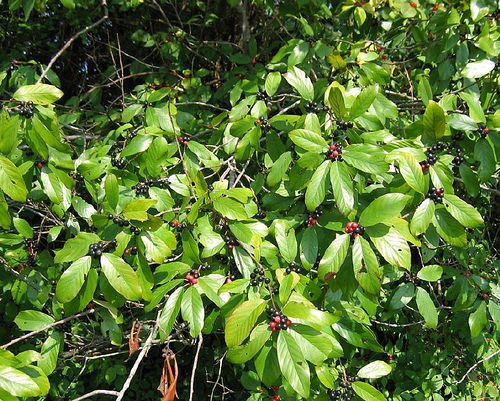
Carolina buckthrown, Frangula caroliniana
(*photo credit)
July 23, 2008 Food Stamps and Commodities
Local food distribution problems affect two different sorts of people: those who are reluctant to get the food even when they need it; and those who are takers when they could earn their daily bread through other means. The first group often have worked hard in life and through illness and old age must now overcome their determined pride and take a hand-out. The second are those who clutter the distribution system and give it a bad name.
The first, once they have been persuaded to take from the food commons, will use the handout wisely and not waste the materials given, nor choose junk food when offered options. Just getting them into the food network is sometimes a chore but is well worth the effort. This group is usually most happy to use the basic staples (grain or prepared flour or cornmeal), cooking oil, canned or dried milk, and beans or equivalents; they will not complain and they are experienced in knowing how to prepare good meals from simple foods.
The other category (the pushy takers) is far more difficult to address. The lazy or the ill-budgeted find it hard to meet needs properly. This often more able-bodied group is actually harmed by a world of easy handouts and can become mere professional beggars; they crowd out those who are more in need of food.
Some of these will go so far as to trade food items, food cash donations or unspecified food cards for drugs. Generally food distributors become experienced enough to control and handle this second category of people.
Granting that some younger inexperienced people are in need of food, we ought to consider their nutritional education. A certain freedom as to what can be purchased within a food stamp program is allowed; this was evident when early on Coca Cola and others were the main proponents, even though some like this writer spoke out against using food stamps for purchase of soft drinks. What becomes evident in such programs is not so much the individuals' right to make food choices, as the taxpayers' right to control what foods are distributed so as to address authentic human food needs.
Food education exists for WIC (Women, Infants and Children) federal programs operated through local health departments. Such education ought to be mandatory for food stamp recipients if a specifically restrictive food distribution policy is not enforced. Such education should include making one's own baked goods, herbal drinks, fixing bean and other non-meat protein materials using a variety of spices and flavorings, preparing healthy snack foods, use of more fruits and vegetables, and choices of meals using less meat. Far too often people prefer buying expensive junk (excessive sugar and fat) foods and neglect more wholesome alternatives.
Prayer: Lord, allow us to give to the poor who are truly hungry and to have the discernment to show tough love to those who should be able to earn their food needs on their own. Help us to teach others what is needed to feed a hungry world.
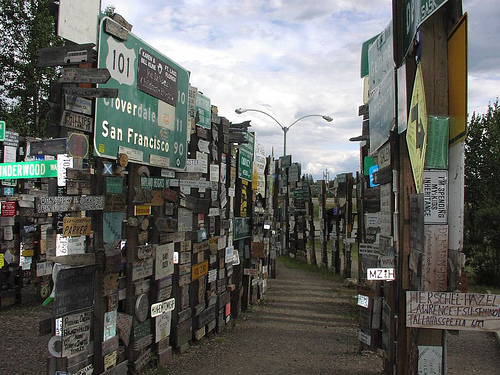
The Signpost Forest, Watson Lake, Yukon
(*photo credit)
July 24, 2008 Global Warming and the Food Crisis
Much has been written about our current food crisis, with escalating food prices of forty percent or more in some of the poor nations. Conventional food surpluses have disappeared due to increased sales to newly developed countries especially China where more resource-intensive foods are being purchased. Another factor is that corn and other grains, sugars and cooking oils are now being converted into biofuels, which adds immensely to the growing shortage of foods. Increased fuel prices for transportation and for petrochemicals in fertilizer all end up in the food product as well. Subsidies given to American and European farmers have discouraged farmers in Africa from growing competing crops. Furthermore, the weather does not always cooperate and droughts help reduce total food production for a given year. One thing is certain, higher food prices mean that poorer folks can buy less with their limited
budgets.
Where does global warming fit into the picture? Yes, the northern temperate zone is extending further north in Canada and Russia, and especially
Siberia. With possible erratic weather associated with global warming, some areas in Africa and Asia and elsewhere could become dryer. Already the deserts have been extending in northern
China by a million acres a year, although hopefully this can be stopped through reforestation and protected grass cover. Global warming could extend African desertification in such poor countries as Niger, Chad and Mali, and these can ill afford further surrender of pasturelands to desert. Our American southeast may become dryer even if not a desert. When possible droughts hit the major food-producing regions such as the American or Canadian Midwest, Australia or Argentina, food shortages will be exacerbated. As in other times of shortages drought results in a ripple effect with the richer food importers taking in more of the scarce commodities and the poorer lands being squeezed still
further.
If icecaps continue to melt and oceans rise a number of inches or feet, one can expect entire island nations to be submerged and thus suffering compounded as people are forced to move to already heavily populated areas. Such nations as the Maldives, Fiji and a number of
Pacific Ocean lands are quite concerned. An added concern is that the change of water flow in major rivers that furnish water for India, Bangladesh and other Asian lands could affect rice and other food growing. We cannot escape what could come or be like ostriches with their heads in the sand. All citizens will be affected in some way as we all are now by rapidly rising food prices. Each citizen has a responsibility to help elect officials who understand the gravity of the situation and are accountable for initiating policies that address global warming. No one is immune because of privilege. We are one world or at least we must become one ASAP.
Prayer: Lord, help us to anticipate additional food shortages and to change our personal and group habits so that all have enough to eat.
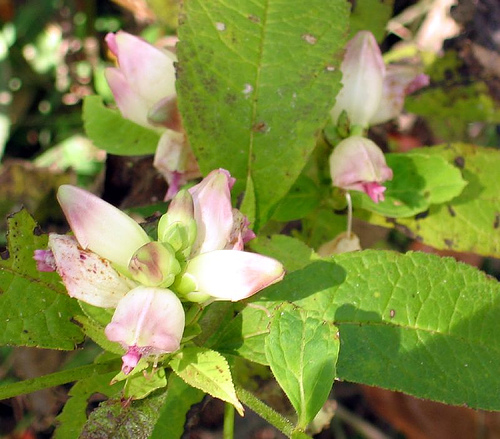
Turtlehead, Chelone glabra
(*photo credit)
July 25, 2008 "Affluenza" versus Simpler Living
Our over-indulging consumer culture suffers from a disease that some term "Affluenza." Just as destitution is undesirable, over-abundance at the other end of the consumption spectrum has its negative effects. A happy medium is the space in which material goods are not too scarce or too abundant and are used responsibly. When speaking of food, "use" means moderating the amount of intensive-resource foods and opting for simpler foods. Many in this world suffer from near destitution. This year the United Nations estimates that one hundred million are in danger of lapsing into destitution for lack of food; other billions lack decent affordable housing and safe drinking
water.
On the other end of the resource spectrum are those who take and use far more than is needed for a healthy life. In fact, just as destitution is an unhealthy condition, so is overabundance or affluenza. The latter is unhealthy spiritually (leading to insensitivity and selfishness) along with a temptation to consume excessive amounts of rich food. Furthermore, this is not just a food condition: overabundance leads to insecurity and overstress in maintaining extensive possessions: vehicles, gadgets, estates, houses. Time is consumed with keeping up with the Joneses and maintaining a privileged fashion expected with a certain status or position. The quality of life deteriorates with such concerns.
A higher quality of life can only be found in a middle course between destitution and overabundance -- and that can be a rather broad zone as to what constitutes sufficiency, and what is overwhelming luxury? The hope is that simpler ways will become more enticing and that their values will become evident in a world that is limited in resources. However, honesty makes us ask whether the majority of lifestyles can change voluntarily or whether they must be modified through deliberate and even drastic legislative measures. The middle course calls for rational and willing cooperation on the part of a democratic people so that the commons may be reclaimed by all and for the benefit of
all.
A more troubling question is whether people can undertake the middle course, if addicted to materialistic consumption. Can they voluntarily come to a simplicity under certain conditions, especially if they are among the great majority of Americans bombarded by advertisements to buy, get a credit card, gamble and as our president says "consume"? Addictions abound and this clouds good judgment, as the recent sub-prime crisis and declining value of houses has brought home to us. Do we continue to fool ourselves, thinking our consumption is under control, and attribute affluenza to the next person?
Should we regulate excessive lifestyle and follow the example of our anti-drug, anti-smoking, or toxic chemical campaigns in regard to consumption in general?
Prayer: Help us realize that too much of a good thing is not good for anyone; inspire us to see that sufficient resources exist for all if not sequestered, wasted or squandered by the privileged few.

A beautiful summer sunset
(*photo credit)
July 26, 2008 Food Wastes
Some institutions concede that one-third of the food cooked is wasted because it cannot be served after being placed out for the public or the people who take the food simply leave it uneaten. With the emerging world's food crisis, any waste of food is simply wrong and should be curbed as much as possible.
This condition calls us to reexamine our own practices. Do we throw out perfectly good food because we are tired of it, we made too much, we prefer a change of menu? Will others complain about leftovers? Some general food waste rules are worth resurrecting: consume only to the degree needed; reuse where possible; and only dispose of when absolutely necessary. Deliberately avoiding wasting food in this food short world is the first step in becoming food conscious.
Reduction of wastes can occur on either end of the food production/consumption chain: growing, processing, transporting and selling on one part and buying, cooking, reusing leftovers and preserving at the other end. Harvesting often leaves good but imperfect-looking produce in the field. Grocery stores often throw out animal products (meat, milk products and eggs), baked goods, and prepared salad materials that are past due dates, but still are edible and acceptable. Over-cooking without regard to reuse is another source of waste.
Creativity comes in reuse of materials such as meat and vegetable leftovers in soups, stews, hashes and other dishes. State laws related to reuse of food are sometimes excessive and require institutions to discard what was only partly used. Ordinances and regulations need to be amended so that Second Harvest and soup kitchens can have access to such leftovers.
On the individual eating end, people often take certain large size portions because they pay for them or because a restaurant serves large portions through its generous traditions. Oversized portions will quite often include more than people can eat -- rather than a moderate amount with a promise of refill if desired. Furthermore, smorgasbord operations result in large amounts of waste by consumers who take far more than they can eat. Because of relatively low food costs in the past such waste has become a custom that ought to be changed. It would be nice to extend some sort of penalty to those who waste food, but how could this be done in our society? Patient education from young to old is needed.
One caveat is that over-emphasis on waste could bring a certain stress and turmoil to households where the parent teaches in a manner that is regarded as pestering the wasteful. Some uneaten food is inevitable. One solution would be to refrigerate the uneaten food and warm it up later and serve it before the wasting person gets other foods. Don't try to stuff a person at a single sitting for some observe that overeating can also be a form of wasting food at the waist.
Prayer: Bless us, O Lord, in the gifts you give us. Allow us to be thankful in the plenty in which we share, and help us to anticipate the amounts needed to meet our daily needs today. Help us to see the moral implications associated with wasting food.
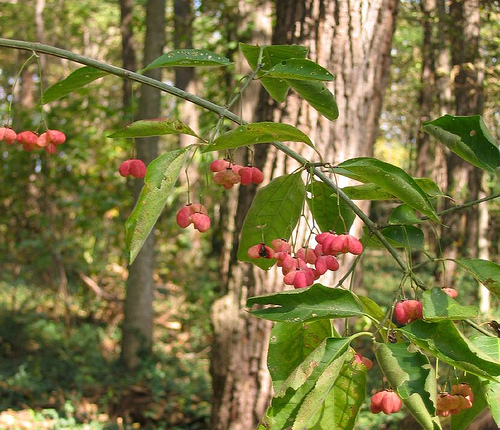
Eastern wahoo, Euonymus atropurpureus. Fayette County, KY
(*photo credit)
July 27, 2008 Directing Attention on the Hungry
Every scribe who is learned in the reign of God is like the head of the household who can bring from the store both the new and the old. (Matthew 13:52)
Treasure hunting and finding captivate us as we read about how the Chile and Peru archeological finds of the past few decades came to light. Whole cities, irrigation systems and troves were discovered through human diligence and hard work. However, most of us do not deal with material treasures and we may remove ourselves from the parables of the treasure and the pearl in Matthew's Gospel. But ought we? We need to see that the treasure we have with us today is all people, those who are healthy and those who are threatened by lack of food. Certainly, we may be tempted to focus attention on the healthy who are enjoying their days and having a well balanced life. It is easy to attend to the healthy and sleek among our older acquaintances; it is hard to gaze on extended bellies and gaunt facial expressions of hungry children even if only in a new photo. The balance is bringing together the old and the new awareness of the condition of our human family.
Like the apostle Paul we see the road ahead to glory and that sets us on a right track that can overcome our depression and make us hopeful. The haunting problems we have today can be overcome with God's grace promised from of old and our efforts, which need to be ever renewed. Through faith we believe that we have the right formula and that we have been empowered by the Holy Spirit.
We have a course laid out for us, a treasure that we find and focus on diligently in order to secure fully the ends towards which we were created.
That treasure includes the millions of hungry souls who are in need of essentials of life to which they are
entitled.
Directing attention is more than merely training ourselves in focusing; we must have the proper goal in mind. In fact, we learn much from the materialistic folks around us who are most diligent in pursuing their own ends of a successful capitalistic enterprise. They teach us about the need to direct attention to specific goals and to gain them at all costs. We can learn their single-mindedness without subscribing to their goals.
We are often distressed by the horror of pictures of poverty in its cruelest manifestations, and yet we make ourselves observe reality. We pray to see the face of Christ coming up to us from each magnificent creature and most especially from those who suffer. It is not the elegant, nor the far away, nor the complex and shining, but rather the poor who can hardly speak because they do not have power or even a way to be intrusive. A deeper form of spirituality is seeing those in the reality of their own suffering, and this is a gift from God. This willingness to observe and help can best be enhanced by accepting our own modern Way of the Cross.
Prayer: With Solomon we pray, Lord give your servant an understanding heart to judge your people and to distinguish right from wrong.
(I Kings 3:9)
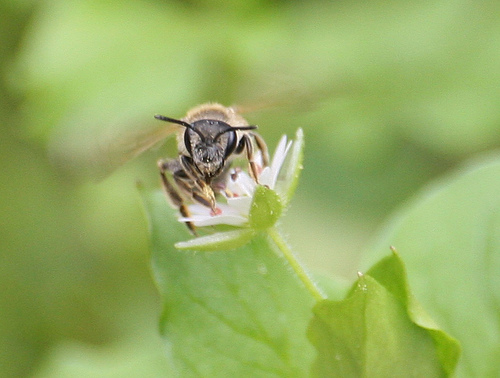
Closeup of a bee, busy at work
(*photo credit)
July 28, 2008 Wildscape and Wildlife
A wildscape is an ornamental landscape that serves several purposes: it can be quite beautiful; it requires less effort to maintain (no frequent mowing); and it offers nesting and feeding places for butterflies, birds and wildlife.
Wildscapes, when well designed, become a source of food for animals. Like work and rest, the combination of cultivated and wild space is harmonious and adds balance to the landscape. Increased wildscape is essential for beneficial insects and birds, which are so hard pressed by the decrease in wilderness areas. Wildlife conservation is a worthwhile goal, and wildscapes attract many species, which are under stress today due to destruction of traditional nesting and feeding areas.
Determine the area that should be in wildscape, where colored wildflowers stand in contrast to solely green lawn. Prepare the ground for the wildscape according to soil requirements and weather conditions. Usually, the initial plot will need tilling. Sow the seed as recommended for your region; seed selection depends on temperate zones. soil type, shading, and desire for a native domestic wildscape. Experiment with varieties. Obtain commercially available native wildflower or prairie grass seed, or seed collected from other local wildscapes. In autumn, gather the wild seed and use it to expand the wildscape, keeping long-term costs low. Consider bordering your first wildscape with brick or stone to show neighbors that a wildscape is deliberately intended. Spectators will be impressed.
------------------
Wildscape
Where a lawn of bluegrass in regimental code,
Once was sowed, mowed and chemically bestowed;
Now dare we grace this untamed place,
With chicory, cornflowers, Queen Anne's lace.
Phlox and yarrow with spring beauty whose
Colors bemuse, patterns enthuse, scents transfuse.
Weekly altered petaled collage; false dragon's head,
Poppy red, ox‑eyed bed, aster tapestry outspread.
Embolden this once addicted patch with iron weed, marigold,
Red clover, goldenrod; the uncontrolled take hold.
Let's sow cosmos to buck the zoning trend,
Let primroses begin, larkspurs befriend, bluets amend.
Resentment is not for critters, insects and butterfly
Who like the trumpet creeper and the Joe Pye.
Black‑eyed Susans bring the greenlace wing,
And make mockingbirds sing and crickets ring.
The picturesque sunflower and scarlet flax command
A grand canvas plan, a hand‑made meadowland.
But human art fails when nature's designs unfold,
Retold in bold splashes. Wildscape behold.

Passiflora incarnata, passion-flower
(*photo credit)
July 29, 2008 Martha and Mary
Americans tend to be busybodies, and so we are defensive when it comes to talking about St. Martha, for she was one also. We fret about whether we have toothpicks in the olives for the party guests and don't think about sitting and conversing with the guest. Martha is the patroness of housekeeping, because the short scriptural narratives about her presence consist of a reprimand -- her sister Mary has chosen the better part. She is too mindful of the minor things while Mary takes a broader perspective.
Let's give Martha credit. In another Scripture passage (raising of her brother Lazarus from the dead), she is one of the very few who calls Jesus by his full title, an act of faith. Recall that she came forth when Mary was overwhelmed with grief. Mary was the one who turned personal tragedy into a moment of greatness; she went out to meet Jesus even though it took an extra effort.
We may not always give full attention to the visitor or the neighbor next door when so many little incidents have to be attended to in our lives. However, we do regard small things as more important than they are. The greatest criticism of a French Marshall Bizarre who was the defeated commander-in-chief in the Franco-Prussian War is that he neglected major operations for minutia including well prepared meals when battle planning was called for. Those with more material possessions can be greatly distracted. One would think that with a house full of electronic gadgets we would have more time for important matters. But the opposite is often true; we are taken up with burnt-out light bulbs and the need to repair the faucet. We fail to see the big picture and to give service in the proper manner when we do see it.
Both Marys and Marthas are needed: willing to see the larger picture and willing to act immediately when needed. For the Christian, the importance of having Christ present is utmost, but how is he present today? Do we hear what he says in the body of the suffering in the world around us? "Do you feed me when I am hungry?" Yes, the challenge is to pause and listen to what Jesus is teaching us -- and this takes a prayerful attention, which some are better at than others. A spiritual attention in times of world hunger means that we listen to the cry of the poor -- for that is Christ speaking to us today. It is so easy to go about being busy and omitting the voices around us. Mary takes the better course, because she stops and listens to what Jesus is saying, but we need to see her role and still carry on our own service as complementary to her being present. Being and doing. While Mary is the model of contemplation and listening to the guest, Martha takes the humbler task of service to the hungry -- and ought to be always satisfied that it is necessary and important. In a hungry world we must hear and act: be contemplatives and be activists all in one, for contemplation-in-action is the best part or undertaking.
Prayer: Lord, allow us to pause, listen and hear the cry of the poor -- you speaking through them. And let us move out and respond with our whole heart and soul to alleviate the hunger.

A faithful friend
(*photo credit)
July 30, 2008 Gardens as Templates of Restoration
Gardens are artifacts of beauty; they manifest both the cooperative handiwork of our Creator and the cooperating diligent creature, the garden-maker. They are models of restoration. The first Eden was God's sole handiwork reserved for human use and a place where people were placed within. Without raising their hands, these first parents stumbled and thought themselves possible equals to God.
After much toiling and sweating we human beings discover that we must do more than live in a pristine garden; we must help remake the second Eden, though we must always be reminded that we are only workers and not the Master Builder. However, the invitation to help remake the garden is part of the redemptive restoration, a gift of being asked to participate in God's work. We are to enhance, improve and rebuild a shattered world and help return Eden to its rightful place as a fruitful garden. We don't act alone in planetary garden-making; we need the cooperation of others; we need divine assistance, and we are most definitely not bystanders. Nature is meant to be touched by human hands.
Having emphasized our human touch we still should not lose sight of the quality of "wilderness" -- God's handiwork from the beginning before our presence. While wilderness is a counterpoint to cultivated garden plots, some of it must be preserved and allowed to flourish as a seed bed and treasure of all forms of life. Even in wilderness preservation human beings are more than observers; we are protectors and preservers of wilderness areas, which are integral parts of the emerging New Eden. Through preservation techniques we learn more about tending gardens. Domestic gardens are remade, not by converting wilderness into gardens, but by turning damaged land into ecological models of what cultivated areas should
be.
This country needs to begin restoration in many areas:
* Wilderness areas -- Let's see that forested and other fragile undeveloped areas remain roadless with limited human incursion so that wildlife can thrive unhindered;
* Wetlands -- Since the first white settlement half of this nation's wetlands have been drained. Losses to these spawning places of biotic life can be compensated by encouraging restoration projects and replacing lost wetlands by artificial wetlands;
* Prairies -- Large portions of the
Great Plains should be returned to buffalo ranges. In fact, the depressed economies of these areas (many of the twenty lowest income counties in the 2000 Census) might actually be raised, if buffalo were restored to the benefit of the Plains Indians and all inhabitants; and
* Lawns to wildscape -- There are place where butterflies, birds and other wildlife can be safe. The use of native plants for cover and food are also a way of reintroducing them into the region.
Prayer: Lord, help us to serve as restorers of that which is damaged and help us make our gardens primary templates of change.

A stately old oak, Franklin Co., KY
(*photo credit)
July 31, 2008 God's Grandeur: An Ignatian Vision
Bright Wings
Gerard Manley Hopkins, S.J. (1844-89)
The world is charged with the grandeur of God.
It will flame out, like shining from shook foil;
It gathers to a greatness, like the ooze of oil
Crushed. Why do men then now not reck his rod?
Generations have trod, have trod, have trod;
And all is seared with trade; bleared, smeared with toil;
And wears man's smudge and shares man's smell; the soil
Is bare now, nor can foot feel, being shod.
And for all this, nature is never spent;
There lives the dearest freshness deep down things:
And though the last lights from the black west went,
Oh, morning, at the brown brink eastwards springs --
Because the Holy Ghost over the bent
World broods with warm breast, and with, ah, bright wings.
Ignatius of Loyola, whose feast we celebrate today, has a vision of the grandeur of God that he extends through writings and thought to all his associates and far beyond to others. The vision is one of Jesus suffering and Jesus triumphant: his suffering and death and rising to a glory that is emerging in our
world.
Ignatius' call comes in early manhood while he recovers from the wounds of battle. He spends his free time in reflecting on The Lives of the Saints, the only book that he has; he gradually turns his mind and heart to an openness to what God calls him to be and do. He becomes a pilgrim with only the clothes on his back; he begs for food and travels without money on a pilgrimage to the Holy Land. While there he enters wholeheartedly into the life of Christ and even tarries until forced to leave. He returns to
Spain and studies beside children half his age, because of his lack of formal education. He spends spare time teaching his emerging Spiritual Exercises
to others by leading them through personal retreats. He is even brought before the Inquisition, which accuses him of being a fanatic and teaching heresy. As he progresses on his journey of learning, he attends the University of Paris and meets a number of others who form a single group, the "Company of Jesus," and thus is born our Society of Jesus. After being unable to fulfill their dream of converting Turks, his small group goes to Rome; and the rest of his life is spent in administration and composing the primary documents for his group. He attends to the poor around him and gives his last efforts to securing the acceptance of a mobile religious community not destined to be a stabilized monastic order.
Prayer: St. Ignatius, inspire us to face today's challenges. Assist us in bringing the suffering Jesus now found in the hungry and poor of the world to the attention of a wider world that seeks a false triumphant materialism.
Let current human suffering penetrate our hearts, and inspire us to speak and act in the defense of the poor. If and when we succeed, let us glory together in the emerging grandeur of God shining out to all the world.